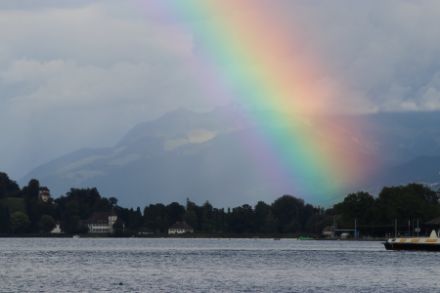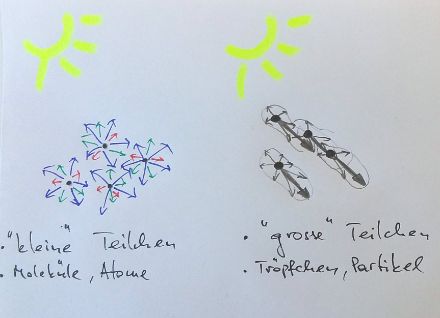Service Navigation
Search
First, let’s delve into a bit of physics. Don’t worry, it won’t get too complicated. Some of the descriptions have been simplified, and we will leave out the scientific formulas or explain them in the text.
Light and colour

Visible sunlight is white. It is composed of seven colours of the spectrum (red, orange, yellow, green, blue, indigo, violet), each of which has a different wavelength. When light passes through a glass prism or through raindrops, these colours become visible due to the refraction of light. The strength of refraction depends on the wavelength. Violet light, which has a relatively short wavelength, is refracted more strongly than red light, with its longer wavelength.
Scattering
On its way to Earth, sunlight encounters an array of atoms, molecules, and other liquid and solid particles in the air (known as aerosols). As a result, some of the light is diverted from its straight path and scattered in all directions. In this way, direct sunlight turns into diffuse light.
Small particles – large particles
If we delve into the details of light scattering in the atmosphere, it gets a little more complicated. The way in which light is scattered depends on both the size of the particles involved and the frequency of the light.

Rayleigh scattering
Let’s start with small particles (air molecules, depicted in the drawing above on the left). In this case, how light is scattered is very much dependent on its wavelength. Blue light, which has a relatively short wavelength, is scattered around 16 times more strongly than red light, with its longer wavelength. Or, to put it differently for those who like formulas: the strength of scattering is inversely proportional to the fourth power of the wavelength. This strong dependence on wavelength has two consequences that we encounter almost on a daily basis:
- Due to the stronger scattering of the blue light component, the sky appears blue. If the Earth had no atmosphere, the sky would be black.
- During sunset, when light travels a longer path through the atmosphere, only the red component of light remains, making the sun appear red.

Mie scattering
However, the atmosphere is not only made up of air molecules. Depending on the weather conditions, water droplets and other aerosols (suspended particles) are also present. These are significantly larger in diameter than air molecules, which means they behave very differently in terms of their scattering (see drawing top right). With these particles, the strength of scattering is barely dependent on the wavelength of light anymore, and all colours are scattered with a similar intensity.
In this case, sunlight is scattered mainly in the forward direction. A simple example of forward scattering is a dirty car window through which headlights or sunlight pass. Because of the forward scattering on the dust particles, the glare from the scattered light is very strong. In the atmosphere, a high proportion of aerosols causes the colour of the sky to appear a paler shade of blue, rather than deep blue.

From deep-blue hues to a pale-blue wash
So now we know that the sky is especially blue when Rayleigh scattering dominates. For this to occur, the air must be as dry and clean as possible. This is mainly the case during the autumn and winter months with stable high-pressure systems and in mountainous areas. When the sun is shining in a deep-blue sky, this is also referred to as a Rayleigh atmosphere.
The blue colour fades increasingly the more humid the air is or the more aerosols it contains. The strong forward scattering effect (Mie scattering) of white sunlight predominates.
